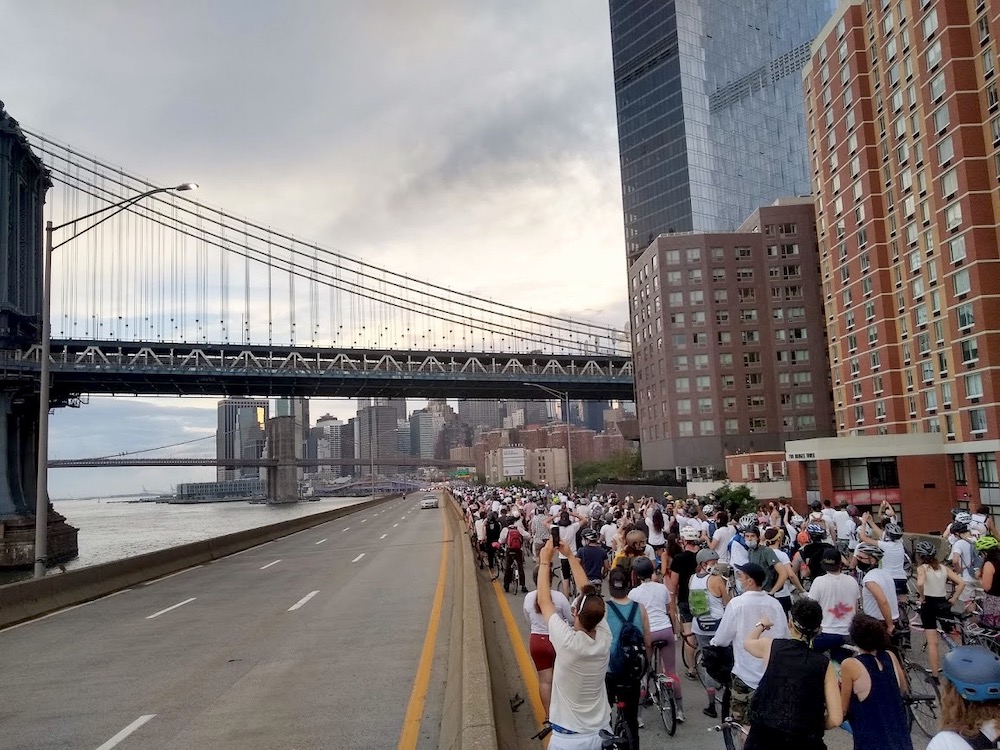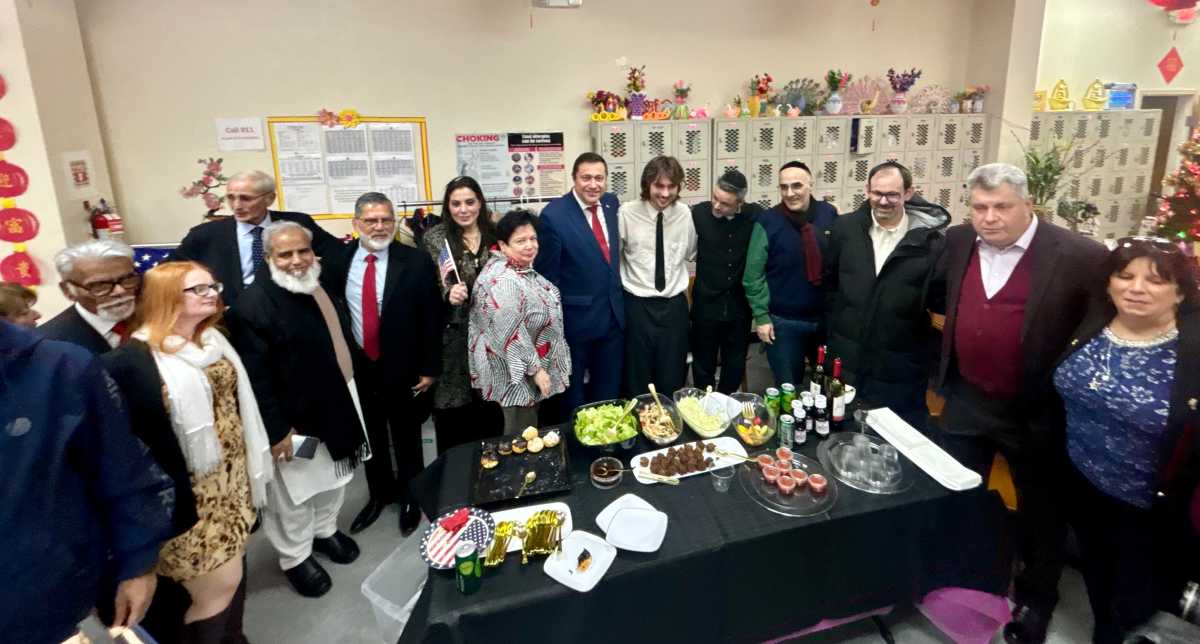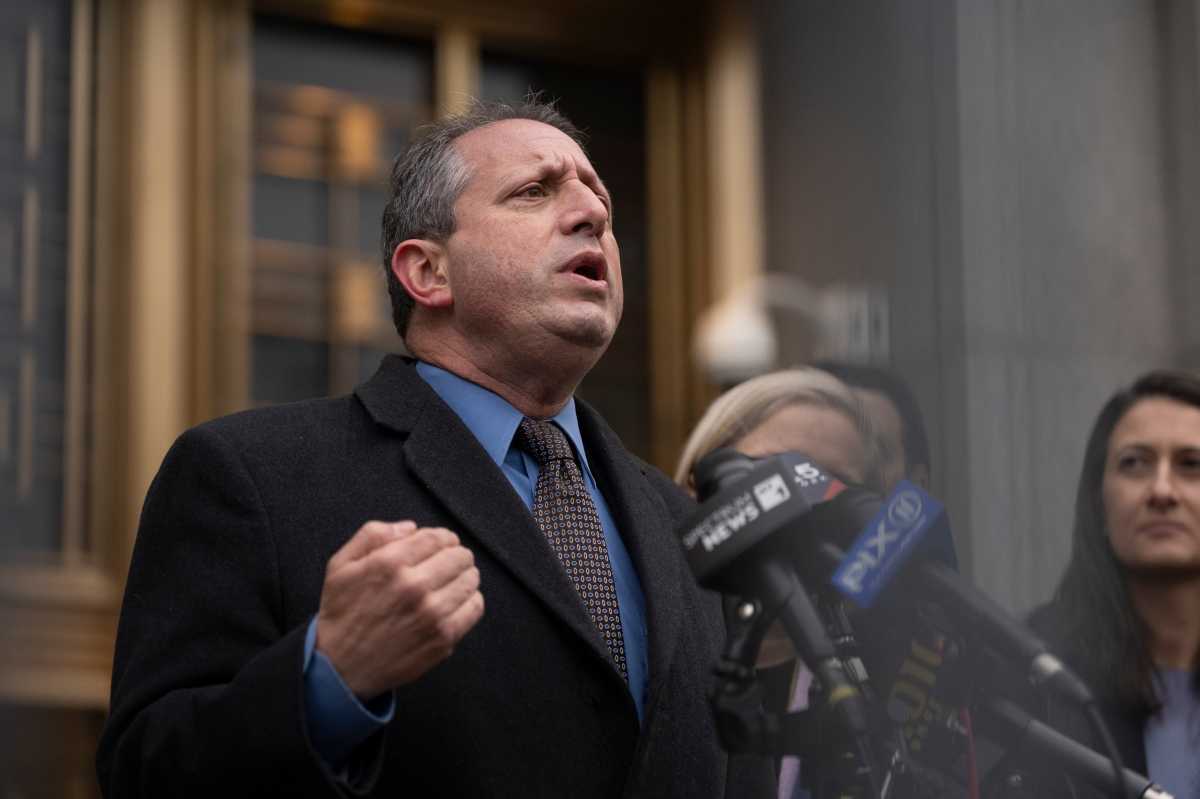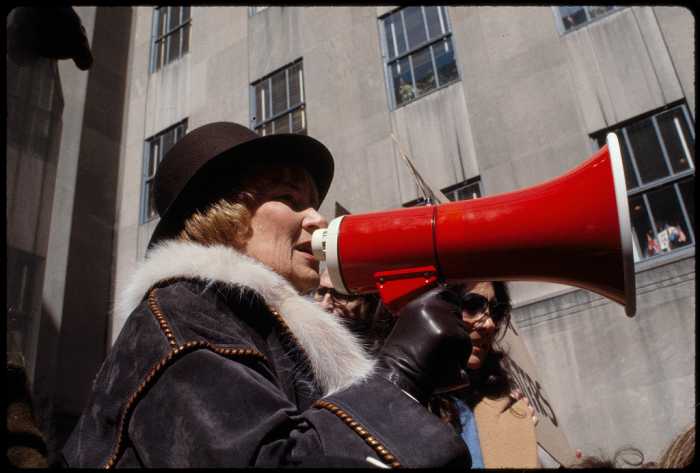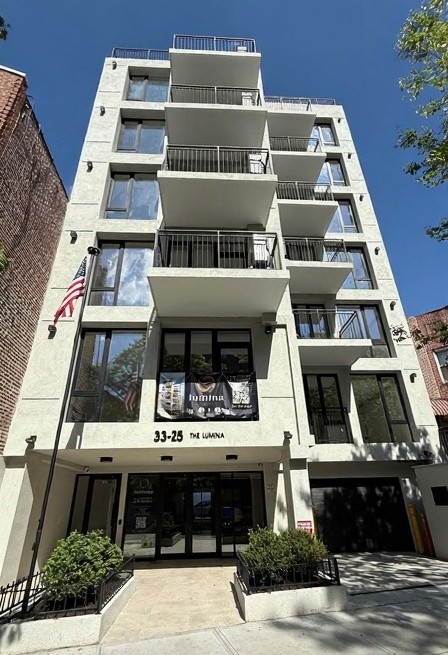The rain and occasional clap of thunder didn’t deter bicycle riders as the area outside Barclays Center steadily filled with mostly white-clad protesters on Saturday.
Organizers using loudspeakers told the group what to expect while bike mechanics and volunteers with supplies went through the crowd to make sure everyone was set. By 5:20 p.m., the rain cleared, and between 500-1,000 bike riders started riding north along the normally traffic-clogged Flatbush Avenue.
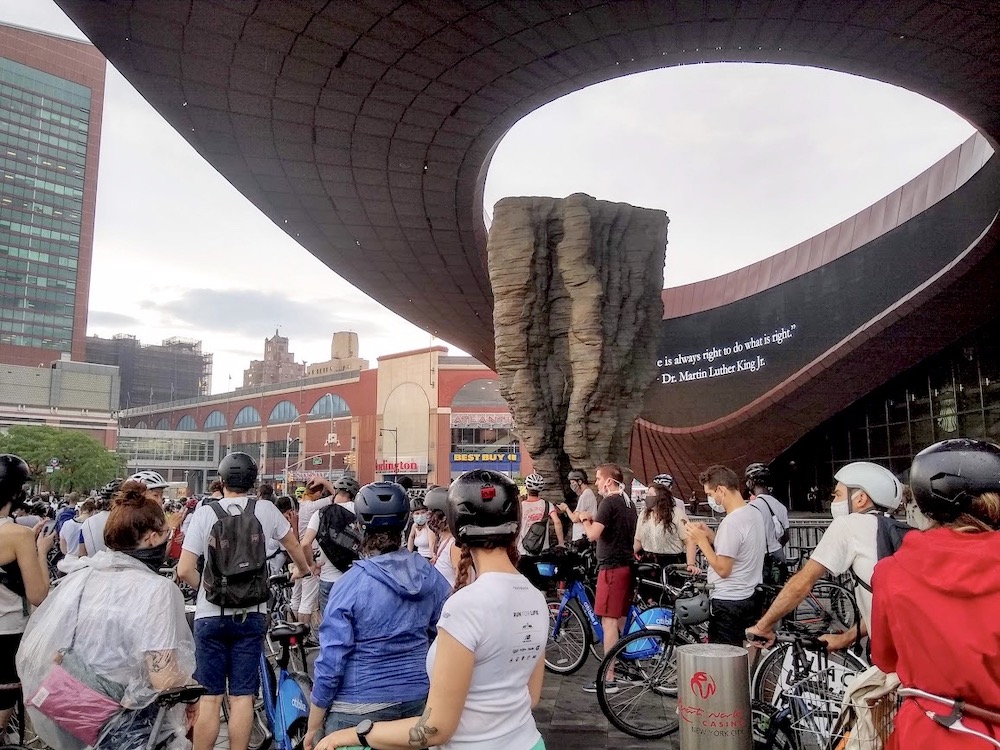
Street Riders NYC is a grassroots movement started by just a few young Black men that contribute to this moment of civil rights protests by bringing together bicycle riders and other wheeled users of all kinds. Like the previous three solidarity rides, this one was big, and only the organizers knew where it was headed.
A once car-crammed city laid dormant for months from the pandemic, and on that cloudy and warm afternoon and evening, a mass of riders chanting in unison took over those same streets to make it loud and clear that black lives matter. The sea of white from everyone’s clothing represented peace and living without fear.
The ride would be about 18 miles and take riders into Manhattan, which they did not know at the time, except for one hint from the organizers at Barclays Center about how the ride would pass Occupy City Hall. Volunteers in yellow vests stopped traffic on Flatbush and Atlantic avenues so the riders could proceed towards Manhattan, but the ride shortly turned onto Lafayette Avenue.
The organizers want to change up the routes each time and show a mix of nice neighborhoods and low-income neighborhoods that do not get as much attention. The protesters could see things like dilapidated buildings and a lack of investment with their own eyes, but the bike ride helps these participants pay close attention to the poor state of the road infrastructure and lack of safety measures for all road users too.
One of the organizers hurt his wrist early on and could not ride his scooter after he ran into a metal bench that was randomly out in the road in a low-income neighborhood. Riders passed along his need for help by shouting “medic” forward through the crowd until medic riders with a medical cross in red tape on their backs got the message and headed back to help.
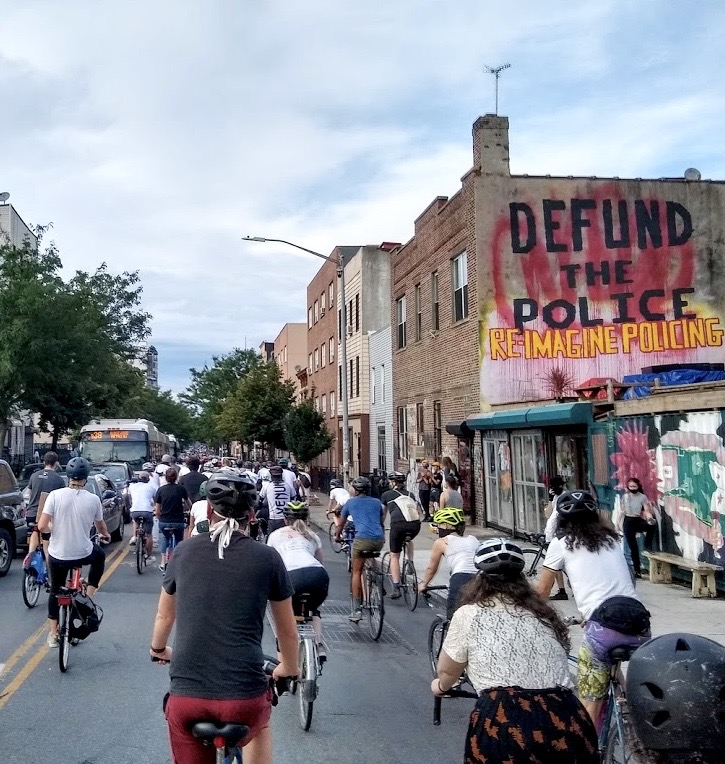
The route took riders through nice neighborhoods like Fort Greene and Clinton Hill before heading east on Myrtle Avenue through Bedford-Stuyvesant to Bushwick and passing through some low-income areas, which was by design to draw contrasts. It went to East Williamsburg and then to the Williamsburg Bridge.
Riders took over the outermost Manhattan-bound roadway on the bridge. People stopped to take unobstructed photos of the river and skyline, and at least one person even smoked a ‘J’ while a Brooklyn-bound J train passed.
Large organized charity rides tend to be planned well in advance because of the logistics of finding space for the start, finish, and rest stops; working with local partners on clearing roads for the route; finding and training staff and volunteers; providing support, food, water, and supplies; worrying about liability; and communicating throughout the event and adjusting to problems on the fly.
This group of seven young organizers plans its solidarity rides each week, and it trains its own volunteers. The rides take over the streets by force of will, mass, and coordination. Volunteers are constantly riding within the group and can provide most of the things that an officially organized ride would, plus masks and hand sanitizer.
Street Riders NYC does not have funding and corporate sponsorships like groups such as the American Cancer Society and the National Multiple Sclerosis Society. One of the organizers, Kieren Cruz, said they can pull off these rides because “we’re organic,” adding that everyone involved has similar goals and wants to keep people safe.
Cruz is thrilled with the diversity and unity he sees at these events, contrasting with the city at its worst. He described the times he’s stepped onto a train and had people look at him as if he were about to rob everyone.
Donning a customized blue vest with “Black Lives Matter” displayed in highlighter yellow, Cruz, a 19-year-old native of Brownsville who now lives in Coney Island, admits that the turnout for the previous rides caught him off guard because he did not expect the rides to blow up so quickly. Last week’s ride that started in Times Square had an estimated 10,000 riders. The annual Five Borough Bike Tour averages about 30,000 riders.
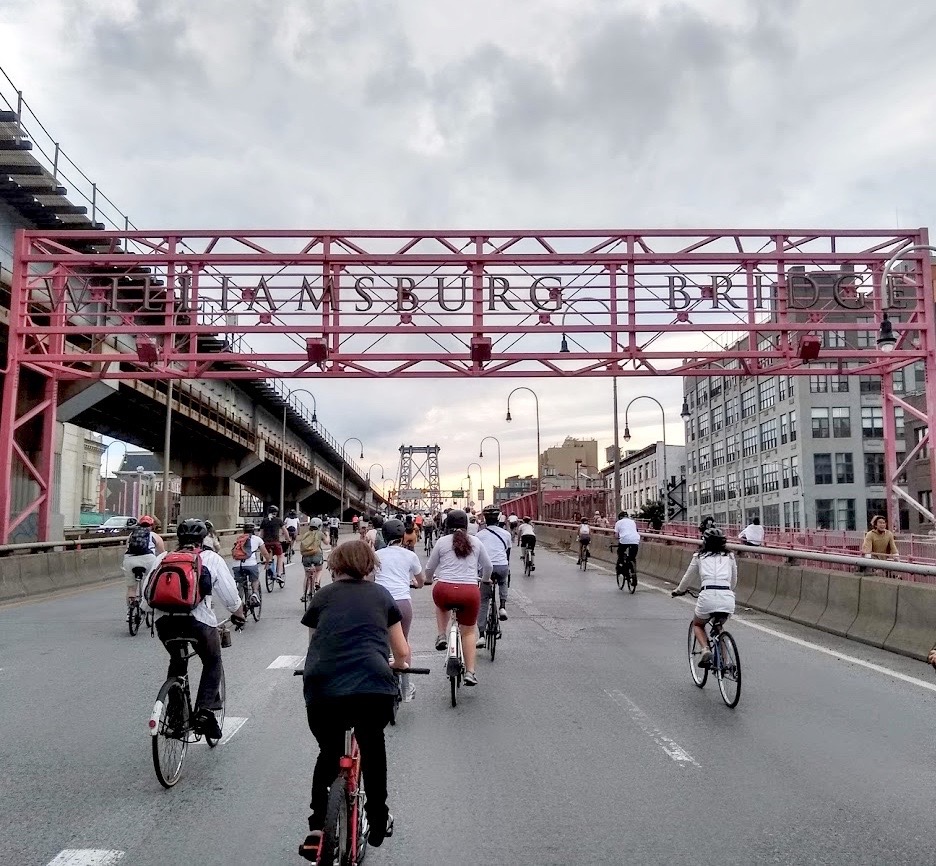
The rides aren’t without hiccups, though. There was some confusion and conflicting information coming from volunteers in the back, which started annoying riders who were doing their best to comply. The constant slowdowns and stoppages at points can get tedious too, but this problem is more reflective of how successful the turnout has been.
Most motorists showed their support, but a few became hot-headed and impatient. One person from a truck apparently threw some small fireworks at protesters near the Williamsburg Bridge, and someone from an unknown spot threw raw eggs at protesters and almost hit me a few times in Bushwick by Myrtle and DeKalb avenues.
As any of the people who have watched from the sidewalks or their apartment windows know, this group understands how to take over the streets. The problem is that Street Riders NYC and other protest groups like it during this movement in response to the state-sanctioned murder of George Floyd have to get their message from the streets to the policymakers.
Street Riders NYC wants to gain allies in City Hall. While it has none yet, Cruz said that they have some lawyers on their side and hope that increased media coverage would help. One tactic is to keep up pressure on social media.
Street Riders NYC mainly uses Instagram and can be found on platforms like Twitter. Cruz said support from City Hall would make them feel “unstoppable.” The organizers asked people to sign a petition to get $1 billion of New York Police Department funds reallocated elsewhere.
City council members may have a hard time staying quiet about Street Riders NYC because of the group’s unmistakable presence. “These protests are meant to disrupt the system and disrupt the police,” Cruz said. “They don’t like that.”
He added that bikes make these protests unique from the others because he’s seen protests where cops are listening in on the organizers’ chatter and getting ahead of them, but on bikes, things are different “because the cops can’t control us.” If all goes well, the organizers want these rides to spring up in other cities, but for now, it is more of a thought than a plan.
Shortly after leaving the Williamsburg Bridge and touching down in Manhattan, the route took riders onto FDR Drive from East Houston Street to head south to exit 2 for City Hall and to pass the Occupy protest. Squeezing upwards of 2,000 riders past Occupy City Hall was a challenge, but they eventually got to Chambers Street and took Church Street to Sixth Avenue to run all the way up to Central Park as the sun set.
After riding up part of the loop inside Central Park on the east side, riders cut across grass and went onto a park path to eventually congregate in a circle on The Great Lawn. Almost four hours after departing Barclays Center, there were still at least 500 riders there to see the ride conclude with some of the organizers saying a few words.
Orlando Hamilton, the most front-facing organizer, spoke to a tired but alert crowd with the backdrop of a lit-up view of Manhattan skyscrapers to the south at nighttime after a long afternoon of civil action. He acknowledged that riding for that long and on a tough route is tiring, “but it’s exhausting being us, every day,” he said, speaking about the experience of living and existing while being Black.
Hamilton was born in Los Angeles and moved to Flint, Mich., in the 1990s. His step-dad thought something was up with the water and moved his family to Swartz Creek, Mich., a predominantly white city of over 5,000 people.
“It was really racist,” Hamilton said of his time there. “It was tough.” He said that similar to when kids drank water in Flint a few years ago because they didn’t know any better, him and his friends would go out and play without realizing the dangers.
While holding back tears, he told a story about when white parents on a street corner gave him a pamphlet that he gave his mom without looking at it. His mom realized the pamphlets encouraged Black parents to get more abortions and stop having kids.
He told the group of bike protesters that those parents felt that the seven Black kids at his middle school were ruining the experience of their white children and that the Black kids were clearly not welcome. “Little n****** babies aren’t allowed in their city,” Hamilton said.
After his mom explained the situation to him, he still did not understand it fully because he was just a seventh-grader. He also tried going to a football game once with friends until they walked past three pickup trucks with Confederate flags and men who brandished firearms and told the kids they were not allowed to go to the game.
At the time, Hamilton did not want to deal with that threat at all and said he lost his desire to go to the game. He wishes he hadn’t felt that way now.
“And you don’t think of it until you grow up how scary that shit is,” Hamilton said. “These are grown-ass men. That’s Ahmaud Arbery,” he said, referring to a man who was pursued and shot to death by three white men earlier this year.
“It’s not over yet,” Hamilton said. “And the reason why we do these rides is to bring y’all together on one common ground and then start attacking these problems that are still going on now.”
When the speaking concluded, the organizers gathered people into groups based on where they were heading home so that everyone could all stay safe together.
These rides show the intersection of racial and economic justice issues with street safety and creating fairer and more equitable streets for all.
COVID-19 has highlighted some of the health disparities that disproportionately plague communities of color, which have been hit hard. Living by heavily used auto roads can cause conditions like asthma, and greenhouse gas emissions continue exacerbating the climate crisis.
Street Riders NYC normally plans rides for Saturday afternoons, and information can be found about the group and its rides at https://www.instagram.com/streetridersnyc and https://www.streetridersnyc.com.


